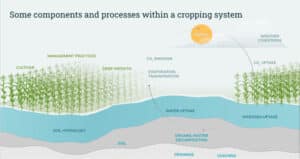Complex environment and plant interactions are best understood when you factor in the whole agriculture ecosystem. Crop models help use quantitative factors to predict plant growth and development as influenced by environmental conditions. To build a crop model, you need to discover the mathematical relationships between a crop, its environment (weather and soil) and management factors (fertilization, planting density) applied to the plants during the growing season. Crop models use these mathematical relationships to simulate different aspects of crop performance to mimic the growth and development of a crop in the real world.
What is a Crop Model?
A crop model is the set of mathematical equations describing how crop genetics, crop management practices, and the environment interact together to determine crop growth. It is in essence a mathematical representation of a cropping system.

Figure 1: Example of a cropping system.
Why is CIBO doing Crop Modeling?
At CIBO, we use mechanistic crop models to understand the interactions within an agricultural system. Mechanistic crop models are essential because they provide interpretable insights into the daily physiological responses of existing and new plant genetics and the outcomes of trait values when exposed to varying conditions. When crop simulation models are combined with statistical models and remote sensing techniques, users can answer a wide range of questions, help optimize inputs and support decisions before planting the first seed.
Example Crop Model Outputs
Models for Plants
CIBO’s plant model describes the development and growth of the crop from planting to maturity. Plant development describes the timing of events that occur during the plant life cycle. These events induce changes in growth rates and partitioning of dry matter to different plant tissues. The model calculates state variables representing various aspects of development and growth at each daily time step.
Example outputs for crops
- Kernels or fruit yield
- Quality
- Biomass
Models for Soil
The soil model describes the different components of the soil layers and how these interact with the environment. This allows the model to estimate the amount of water and nutrients available for uptake by the growing plant. Root development occurs at each daily time step: the root tips progress through the soil layers, and the root mass increases. This results in water and nutrient uptake in the soil horizons that are in contact with the plant’s rooting system, proportional to the root mass distribution in each soil horizon. By this method, the model reflects the complex interactions whereby the soil and weather influence plant growth and plant growth subsequently changes the soil dynamic.
Example outputs for soil
- Runoff
- Nutrient utilization
How Model Crop Modeling Improves Yield Predictions
The agricultural knowlede curated and prepared in CIBO’s data integration technology populates a dynamic, science-based digital model purpose-built for performing highly resolved simulations of complex crop and environment interactions. Grounded in agronomic science, this unique system model dynamically simulates a crop’s response to environment, management, water, weather, and soil as they interact over the course of a growing season, tracking a crop’s virtual growth in its environment under the conditions specified by the model’s inputs.
This high-fidelity model accurately represents the complex behavior, interactions, and responses across factors including plant, soil, water, solar energy, management interventions, nutrients, temperature, weather, wind, climate, and more. It tracks growth at a highly resolved daily time-step as it simulates a growing season in milliseconds. And, by leveraging high-powered computing, the digital model simulates crop growth under not just one but millions of possible scenarios at scale – in a matter of just hours – to accurately predict performance across a wide array of possible scenarios. Not only can the model accurately simulate what did happen, as validated by years of scientific study under real-world use cases and applications, it can accurately simulate what could happen, allowing users to select new inputs for potential new, future scenarios that could impact crops and environments – including new crop traits, new changes to weather, new geographic locations, new environmental conditions, new market needs, new management techniques, and more.



